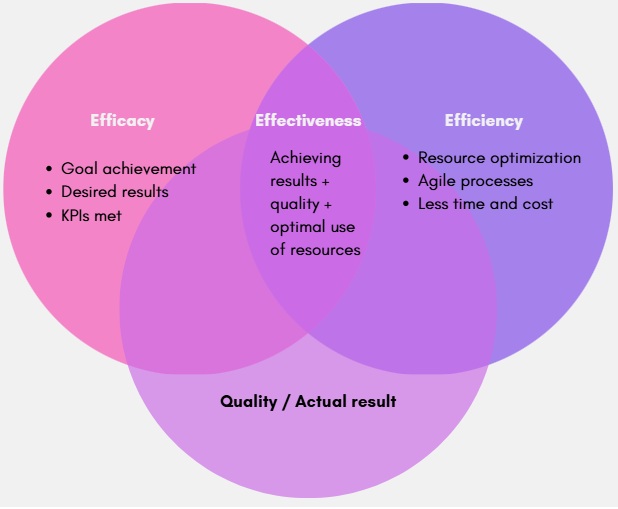 Freelancer tips
Freelancer tips Problem-solving strategies: Steps and examples
Using problem-solving strategies is key to increasing the chances of achieving better results. These are the most useful ones.



Efficiency and effectiveness are two essential pillars for modern management and strategic decision-making. The former analyzes how resources are used, while the latter evaluates the ability to achieve results.
A company that truly understands efficiency and effectiveness, and wants to be effective, not only aims to meet goals, but to do so in the best possible way.
In the business world, this combination becomes key to operating with precision, reducing waste, and adapting to market changes. DolarApp is a clear example, balancing efficient processes with effective execution.
So, if you want to improve efficiency and effectiveness to boost business performance, keep reading this post. Here you’ll discover the essential steps to achieve it and how you could enhance these qualities.
Efficiency and effectiveness are related concepts, but they’re not the same:
Efficiency. The ability to obtain a result while optimizing the means employed.
Effectiveness. The ability to meet defined objectives without analyzing how many resources were used in the process.
In simple terms, as Peter Drucker puts it:
Efficiency is about doing things right, while effectiveness is about doing the right things.
Together, they form the basis of modern management geared toward sustainable results and, thanks to that combination, you get solid effectiveness.
The main difference between effectiveness and efficiency is that they approach results from different angles.
To briefly explain the differences between effectiveness and efficiency, here’s a comparison table:
Efficiency | Effectiveness |
Central focus | Internal processes and use of resources. |
Priority | Make better use of time, budget, and team. |
Example | Serve the same number of customers in less time and with the same staff. |
In short, effectiveness focuses on meeting the goal, and efficiency on how resources are used to achieve it.
In the business realm, efficiency and effectiveness influence strategic decisions—for example, how the marketing mix is defined and how business initiatives are prioritized. When they complement each other, both become essential for product development as well as service delivery.
On one hand, business efficiency is reflected in how resources are managed: cost structure, use of time, staff allocation, and process design.
Business effectiveness, on the other hand, is observed in goal attainment: objectives achieved at each stage of the product life cycle, sales closed, projects delivered, and—above all—satisfied customers.
When both approaches are integrated, effectiveness emerges.

Therefore, if you want to run an effective business, meet your objectives. But if you seek effectiveness in the fuller sense, do it by optimizing resources, keeping costs in check, and caring for the customer experience.
Improving efficiency and effectiveness requires simple, well-organized strategies. To do so:
Set SMART objectives.
Measure results and cycle times.
Train your team and optimize processes.
Use technology.
Promote a culture of accountability and continuous improvement.
Start by clarifying what you want to achieve and by when. Turning goals into Specific, Measurable, Achievable, Relevant, and Time-bound (SMART) helps you prioritize without losing focus.
Financial goals must align with the business vision and translate into concrete results.
Evaluating both outcomes and cycle times lets you detect deviations in time and adjust workloads without improvisation.
Effectiveness is reinforced through constant measurement, and efficiency improves when time use is optimized.
Therefore, you can use quality indicators to measure team performance, customer satisfaction, and process consistency. At the same time, you could encourage Deep Work habits to boost productivity. This will help reduce time spent on repetitive or low-priority tasks.
Review how work is done and eliminate steps that don’t add value. Ongoing training and standardizing best practices reduce rework and raise quality consistently.
Automation helps improve business performance by reducing errors and increasing both the quality and speed of work.
Identify manual activities that consume many hours and evaluate tools that simplify them.
Some useful options are Zapier, Asana and HubSpot.
Assign clear owners for each goal and set brief review sessions. A steady rhythm of small improvements keeps you on track and prevents problems from piling up.
To understand how these concepts are applied in practice, it helps to explain them independently.
That’s why the following example shows the difference between efficiency, effectiveness, and effectivity within a business:
Efficiency: streamlining customer support to resolve requests in less time while maintaining the same quality level.
Effectiveness: meeting the goal of increasing monthly sales by 20% according to the plan.
Effectivity: achieving that goal with more coordinated operations and execution that drives productivity and consistent results.
DolarApp is a real case.
We combine effectiveness by offering reliable financial services with efficiency thanks to fast operations centered on the user experience.
Efficiency and effectiveness are concepts that, together, become a real competitive advantage.
When a company cares about how it uses its resources and meets its objectives, it creates a stronger foundation for moving forward. This allows it to grow profitably, adapt better to the market, and sustain results consistently.
So, if you want your business to remain relevant, start by asking whether you’re reaching your objectives. If so, how are you achieving them, and what could you do to get better results from each effort?
It’s not about changing everything overnight, but progressing with small adjustments. This way, you can fine-tune resource use and the impact of every action.
That’s why it’s important to review how you work: define clear goals and measure what matters against the results you want to achieve.
Remember you can rely on DolarApp to optimize your time and finances with simple, effective management. We offer a fair, transparent exchange rate for buying and selling USDc and EURc.
Plus, you can send or receive payments for a 3 USDc/EURc fee regardless of the amount.
Efficiency means using resources in the best possible way, while effectiveness means meeting the objectives set. Combined, they enable a company to create more value, reduce waste, and improve its competitiveness in the market.
The focus: effectiveness centers only on whether the expected results are achieved, and efficiency on how resources are used. That’s why companies usually apply both to operate better and achieve sustainable goals.
Both, because when a company is effective and efficient at the same time, it maximizes its impact, profitability, and long-term stability. However, effectiveness is often prioritized, since it guides how to optimize resources if results aren’t being met.
Business effectivity is achieved by balancing efficiency and effectiveness: optimizing processes, using resources well, and meeting objectives. But it also requires clear leadership, good communication, and a culture oriented toward continuous improvement.
Sources:

Os países têm fronteiras. Suas finanças, não mais.
 Freelancer tips
Freelancer tips Using problem-solving strategies is key to increasing the chances of achieving better results. These are the most useful ones.

 Freelancer tips
Freelancer tips Designing a solid training plan reduces errors and helps teams work with greater clarity. Here are the 5 stages to build one effectively.


